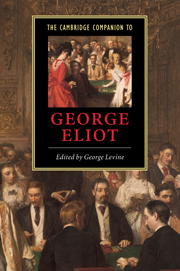Book contents
- Frontmatter
- 1 Introduction
- 2 A woman of many names
- 3 The early novels
- 4 The later novels
- 5 George Eliot and philosophy
- 6 George Eliot and science
- 7 George Eliot and religion
- 8 George Eliot and politics
- 9 George Eliot and gender
- 10 George Eliot and her publishers
- 11 George Eliot
- 12 Works cited and further reading
- Index
3 - The early novels
Published online by Cambridge University Press: 28 May 2006
- Frontmatter
- 1 Introduction
- 2 A woman of many names
- 3 The early novels
- 4 The later novels
- 5 George Eliot and philosophy
- 6 George Eliot and science
- 7 George Eliot and religion
- 8 George Eliot and politics
- 9 George Eliot and gender
- 10 George Eliot and her publishers
- 11 George Eliot
- 12 Works cited and further reading
- Index
Summary
George Eliot began her career as a novelist in a frenzy of activity, producing from the start works of exceptional quality for a novice. After the initial publication in serial form in Blackwood's Edinburgh Magazine of the three stories that would make up Scenes of Clerical Life in 1857, her first works of fiction were published at the rate of almost one a year: Scenes of Clerical Life (1858), Adam Bede (1859), The Mill on the Floss (1860), Silas Marner (1861), Romola (published serially in Cornhill Magazine from July 1862, and in three volumes by Smith, Elder, in 1863). In addition, she also published her novella, “The Lifted Veil,” in Blackwood's in 1859, and wrote a second novella, “Brother Jacob,” in 1860, although this was not published until 1864. While the rate of production in what we might think of as the second part of this career was certainly intense (six works of fiction and poetry over thirteen years), in comparison with the first it seems almost leisurely. Just five years into the novelist's career, then, the critic Richard Simpson was already in a position to write a retrospective review. In this, Simpson conveys the impact George Eliot's fiction had made on the reading public when it first appeared: “Readers who in 1858 took up the Scenes of Clerical Life . . . with the languid expectancy with which the first writings of new novelists are received, were astonished that, instead of an author, they had found a man” (CH, 221).
- Type
- Chapter
- Information
- The Cambridge Companion to George Eliot , pp. 38 - 56Publisher: Cambridge University PressPrint publication year: 2001
- 4
- Cited by



